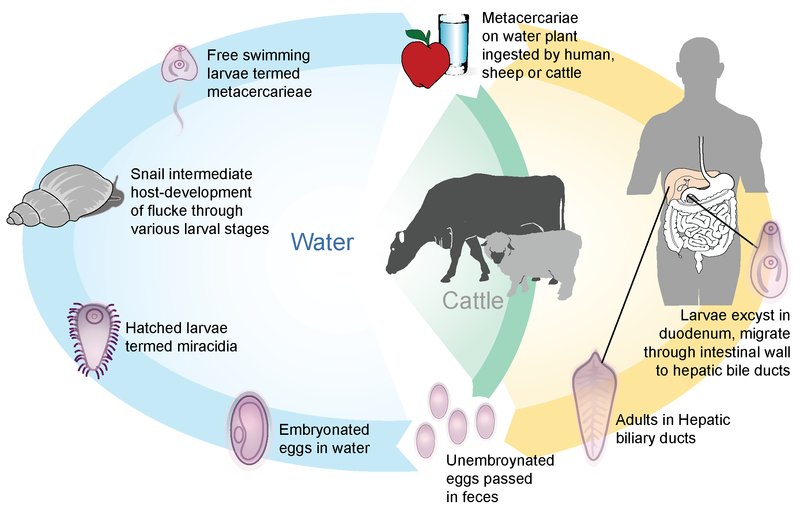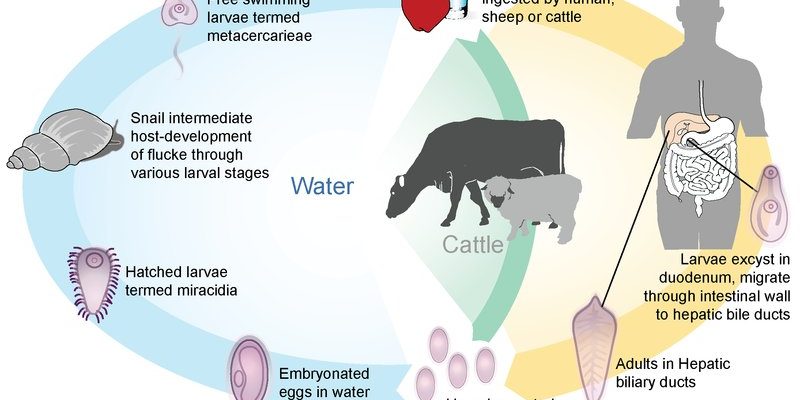
Liver flukes, particularly *Fasciola hepatica* and *Fasciola gigantica*, have complex life cycles that can involve multiple hosts, including snails and various mammals. This complexity allows them to interact with their environment in surprising ways. Think of them as uninvited guests at a dinner party; they might cause some disruption, but they’re also part of the mix that makes the gathering complete. Let’s dig deeper into why these parasites are more than just pests and learn about their ecological impact.
The Life Cycle of Liver Flukes
Liver flukes have what you might call a ‘double life’—one that spans various hosts, which shapes their ecological role. The cycle begins when a herbivore, like a cow or sheep, grazes on contaminated grass, ingesting the fluke larvae. Inside the animal’s liver, the larvae develop into mature flukes that produce eggs. These eggs are then excreted back into the environment, where they find their way into freshwater bodies.
In water, the eggs hatch into larvae and infect freshwater snails, which serve as the first intermediate host. Here’s the interesting part: the flukes undergo several developmental stages within the snails before they’re ready to infect their final host. It’s a bit like a relay race, where the baton gets passed from one runner to the next, each stage crucial for the completion of the cycle. This intricate dance ensures that liver flukes can spread through ecosystems, affecting various species along the way.
The Role of Liver Flukes in Ecosystems
While liver flukes may seem like troublemakers, they play a surprisingly cool role in their environments. Their presence can indicate the health of an ecosystem, much like canaries in coal mines used to signal danger. When liver flukes thrive, it often points to a balance in water quality, vegetation, and host populations. They interact with their surroundings in ways that can actually help control other populations of organisms.
Additionally, liver flukes can impact nutrient cycling. For example, when they infect herbivores, they can influence the grazing patterns of these animals. If an animal is sick, it might graze less, allowing certain plants to flourish while culling others. This selective pressure can create new plant communities, diversifying the habitat and providing opportunities for other species to thrive. It’s a complex interplay that shows how even the smallest creatures have significant effects on their ecosystems.
Impact on Host Populations
Liver flukes affect not just the plants but also the host animals, and this can ripple through the food chain. When a population of livestock is heavily infected, their productivity drops. Animals may suffer from weight loss, reduced milk production, or even death if the infection becomes severe. This not only impacts farmers but also changes predator-prey dynamics in the area.
Predators who rely on these herbivores may find themselves with less food. This creates a feedback loop; as the herbivore population declines, predators might move elsewhere or face starvation, which in turn affects the entire ecosystem. You can think of it as dominoes falling—you knock one down, and they all start to tumble. The balance of nature is delicate, and liver flukes play a role in maintaining that balance, even if they cause problems for the hosts involved.
Interactions with Other Species
Liver flukes don’t just affect livestock; their lifecycle and presence shape interactions with a variety of other species. The snails that serve as intermediate hosts are crucial in their lifecycle, but they’re also integral to the aquatic ecosystems. When liver flukes infect snails, it can affect their behavior and population dynamics. For instance, infected snails might become more vulnerable to predation, which can help keep their populations in check and influence the overall health of freshwater habitats.
Moreover, the flukes can serve as a food source for some species. Birds, for instance, may prey on infected snails, and in turn, their populations can fluctuate based on the availability of these infected individuals. It’s a real game of interconnectedness; when you tug on one thread of the web, you feel the effects rippling throughout the entire fabric of the ecosystem.
The Human Perspective: Benefits and Challenges
For humans, liver flukes represent both challenges and unexpected benefits. On one hand, they pose significant health concerns, especially in agricultural settings where livestock infections can lead to economic losses. Farmers must take measures to control these parasites, which can involve medications or adjusting grazing strategies.
On the flip side, the study of liver flukes can offer insights into disease control and ecosystem health. Scientists are constantly researching how these organisms function within their environments and what this means for overall biodiversity. By understanding their life cycle and interactions, researchers might find innovative ways to manage livestock health and improve environmental outcomes. It’s a reminder that sometimes, the things we see as problems can lead us to unexpected solutions.
Conservation and Liver Flukes
Finally, let’s touch on conservation. The role of liver flukes in their ecosystems can signal changes in environmental health, which is crucial for conservation efforts. If populations of liver flukes start to dwindle, it may indicate issues like pollution or habitat destruction. Monitoring these parasites can serve as a low-cost way to assess the health of ecosystems, guiding conservation strategies.
Furthermore, as we face challenges like climate change, understanding how liver flukes and their hosts respond to changing conditions will be vital. These organisms have adapted over millennia, but how will they fare in a rapidly evolving environment? Researchers are keen to find out, as the answers could help protect both animal and plant life in compromised habitats.
In conclusion, the ecological importance of liver flukes goes beyond their parasitic nature. They play essential roles in their ecosystems, influencing everything from nutrient cycling to host populations. While they may not be the most glamorous creatures, their interconnectedness with other species and their environment is a testament to the complexity of nature. Understanding and respecting these tiny organisms can lead us to better manage our ecosystems and protect the delicate balance of life on Earth.

